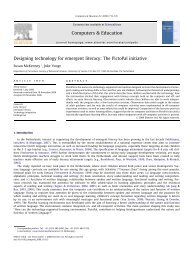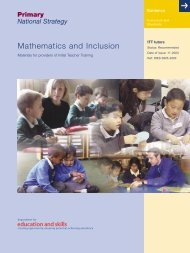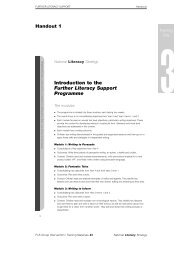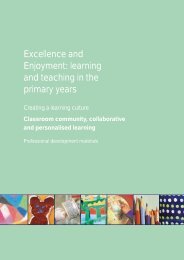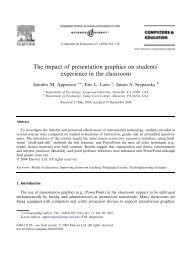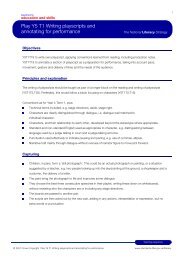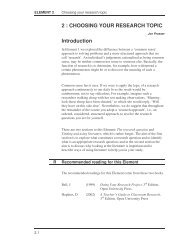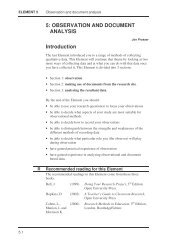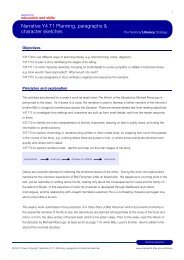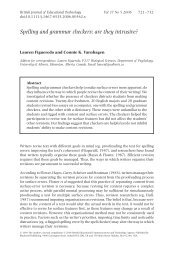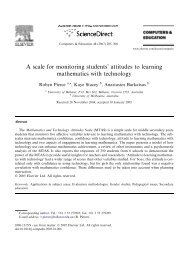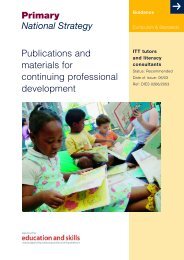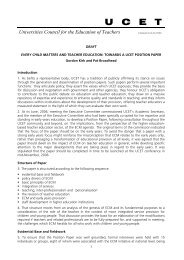assessment â summative and formative â some theoretical ... - PGCE
assessment â summative and formative â some theoretical ... - PGCE
assessment â summative and formative â some theoretical ... - PGCE
You also want an ePaper? Increase the reach of your titles
YUMPU automatically turns print PDFs into web optimized ePapers that Google loves.
British Journal of Educational Studies, ISSN 0007-1005Vol. 53, No. 4, December 2005, pp 466–478– SUMMATIVE AND FORMATIVE –SOME THEORETICAL REFLECTIONSby MADDALENA TARAS, University of Sunderl<strong>and</strong>ABSTRACT: This paper wishes to clarify the definitions of the centralterms relating to <strong>assessment</strong>. It argues that all <strong>assessment</strong> beginswith <strong>summative</strong> <strong>assessment</strong> (which is a judgement) <strong>and</strong> that <strong>formative</strong><strong>assessment</strong> is in fact <strong>summative</strong> <strong>assessment</strong> plus feedback which is usedby the learner.Keywords: <strong>assessment</strong>, <strong>summative</strong>, <strong>formative</strong>, definitions, theory1. IntroductionAssessment is of central importance in education, <strong>and</strong> yet there is alack of commonality in the definition of the terminology relating toit. Development of both <strong>theoretical</strong> <strong>and</strong> practical applicationswill suffer unless there is coherence <strong>and</strong> agreement in the definitionof the terms. Assessment for learning or <strong>formative</strong> <strong>assessment</strong> (FA)is increasingly being emphasised, yet its relationship to <strong>summative</strong><strong>assessment</strong> (SA) has been little explored.This paper will examine, first, the central terminology <strong>and</strong> definitionsrelating to <strong>assessment</strong>; second, the literature <strong>and</strong> current<strong>theoretical</strong> discussions pertaining to <strong>summative</strong> <strong>assessment</strong> <strong>and</strong><strong>formative</strong> <strong>assessment</strong>; <strong>and</strong> third, implications for the realignment ofdefinitions <strong>and</strong> practice. It returns to basic principles of SA <strong>and</strong> FA;that is, to Scriven who first made the distinction.Since Scriven, there have been developments, both <strong>theoretical</strong><strong>and</strong> practical in the area of <strong>assessment</strong>. However, the tenets whichdescribe the basis of <strong>assessment</strong> remain essentially the same.2. DefinitionsThe Terms ‘Evaluation’ or ‘Assessment’The terms ‘Evaluation’ or ‘Assessment’ are both in common usagein educational circles. In the UK, the common use of the term© Blackwell Publishing Ltd. <strong>and</strong> SES 2005466
ASSESSMENT – SUMMATIVE AND FORMATIVE‘<strong>assessment</strong>’ is to refer to judgements of students’ work, <strong>and</strong> ‘evaluation’to refer to judgements regarding courses or course delivery, orthe process of making of such judgements. This is how these termswill be used in this paper, for the sake of clarity <strong>and</strong> consistency,other than in quoting writers who have done otherwise. For example,Scriven uses ‘evaluation’, as do most US academics, in the sense of‘<strong>assessment</strong>’ as used in this paper.Definition of AssessmentLike Scriven, I take ‘<strong>assessment</strong>’ to refer to a judgement which canbe justified according to specific weighted set goals, yielding eithercomparative or numerical ratings. For him it is necessary to justify(a) the data-gathering instruments or criteria, (b) the weightings<strong>and</strong> (c) the selection of goals (Scriven, 1967, p. 40). I argue that itis necessary to add a further stage – that of justifying the judgementagainst the stated goals <strong>and</strong> criteria.The Assessment ProcessThe process of <strong>assessment</strong> is the mechanics or steps required toeffectuate a judgement. A judgement cannot be made within a vacuum,therefore points of comparison, i.e. st<strong>and</strong>ards <strong>and</strong> goals, are necessary.The criteria narrow the choices of specific items which are consideredimportant <strong>and</strong> relevant for any specific judgement withinany given context. Therefore, within the process are manifest theparameters within which the judgement is made. In other words,during the process of making a judgement, all these elements are inconstant inter-play. All <strong>assessment</strong>s require these parameters <strong>and</strong>these can either be explicit or implicit (Black <strong>and</strong> Wiliam, 1998, p. 8;Sadler, 1998, p. 2). With implicit parameters, any second assessor isplaying a guessing game as to which points will be salient within anassessor’s mind. Explicit parameters go <strong>some</strong> way towards creatinga shared forum for <strong>assessment</strong> <strong>and</strong> therefore allowing transparencyof process, although within any given context, meanings can <strong>and</strong>do vary between individuals (for a discussion of ‘fuzzy criteria’ seeSadler, 1989).3. Scriven: The Process of AssessmentIn his seminal paper, Scriven states that <strong>assessment</strong> is a single process.Evaluation is itself a methodological activity which is essentiallysimilar whether we are trying to evaluate coffee machines or© Blackwell Publishing Ltd. <strong>and</strong> SES 2005467
ASSESSMENT – SUMMATIVE AND FORMATIVEteaching machines, plans for a house or plans for a curriculum.(Scriven, 1967, p. 40)Therefore, <strong>assessment</strong> is <strong>assessment</strong>. Assessment is an integral part ofall aspects of daily life. Scriven was working in the context of curriculumevaluation, but the principles he discusses are universally relevantto all <strong>assessment</strong>.Summative AssessmentThe process of <strong>assessment</strong> leads to <strong>summative</strong> <strong>assessment</strong>, that is, ajudgement which encapsulates all the evidence up to a given point.This point is seen as a finality at the point of the judgement. A <strong>summative</strong><strong>assessment</strong> can have various functions which do not impingeon the process.Formative AssessmentSince the process of <strong>assessment</strong> is, as Scriven notes, a single process,i.e. making a judgement according to st<strong>and</strong>ards, goals <strong>and</strong> criteria,FA is the same process as SA. In addition, for an <strong>assessment</strong> to be<strong>formative</strong>, it requires feedback which indicates the existence of a‘gap’ between the actual level of the work being assessed <strong>and</strong> therequired st<strong>and</strong>ard. It also requires an indication of how the work canbe improved to reach the required st<strong>and</strong>ard.Therefore, both SA <strong>and</strong> FA are processes. It is possible for <strong>assessment</strong>to be uniquely <strong>summative</strong> where the <strong>assessment</strong> stops at thejudgement. However, it is not possible for <strong>assessment</strong> to be uniquely<strong>formative</strong> without the <strong>summative</strong> judgement having preceded it.This SA can be implicit <strong>and</strong> the <strong>formative</strong> focus only made explicit,or both SA <strong>and</strong> FA process can be explicit (Black <strong>and</strong> Wiliam (1998,p. 8) favour implicit while Sadler (1998, p. 2) requires explicitexpression of SA).The ‘Role’ or ‘Function’ of Assessment‘Role’ <strong>and</strong> ‘function’ are used synonymously in this paper. The functionsof <strong>assessment</strong> refer to its intended use or purpose. The choiceof function does not impinge on the actual process of <strong>assessment</strong>,but it will affect the choices of the parameters of the <strong>assessment</strong>.Therefore, the goals, st<strong>and</strong>ards <strong>and</strong> criteria will, to <strong>some</strong> degree, beinfluenced by the choice of function. Although we would expect theeducational functions to predominate, often it is the social needswhich come to the fore (Broadfoot, 1996; Filer, 2000).© Blackwell Publishing Ltd. <strong>and</strong> SES 2005468
ASSESSMENT – SUMMATIVE AND FORMATIVEFunctions are many <strong>and</strong> can be combined into multiple uses (seeBlack <strong>and</strong> Wiliam, 1998; Sebatane, 1998 for detailed discussion ofthis issue). ‘Evaluation can <strong>and</strong> usually should play several roles’(Scriven, 1967, p. 41). The problems then presented by Scriven arevery pertinent to the current situation in education. If we wish to prioritiseeducational goals over social roles of <strong>assessment</strong>, these truthsshould be faced <strong>and</strong> solutions brought into effect.Failure to make this rather obvious distinction between the roles<strong>and</strong> goals of evaluation, not necessarily in this terminology, isone of the factors that has led to the dilution of the process ofevaluation, to the point where it can no longer serve as a basis foranswering the questions which are its goal. This dilution sacrificedgoals to roles. (Scriven, 1967, p. 41)Assessment permeates every aspect of our lives, <strong>and</strong> is a natural <strong>and</strong>automatic activity (Rowntree, 1987, p. 4). In the educational context,the terrors evoked by the term ‘<strong>assessment</strong>’ have distorted its necessity,centrality <strong>and</strong> its potentially neutral position. Indeed ‘<strong>assessment</strong>’ isconsidered so negative that the term ‘evaluation’ was preferred formany years. Currently, FA is the antiseptic version of <strong>assessment</strong> <strong>and</strong>SA has come to represent all the negative social aspects.One of the reasons for the tolerance or indeed encouragementof the confusion between the roles <strong>and</strong> goals is the well-meaningattempt to allay the anxiety on the part of teachers that the word‘evaluation’ precipitates. By stressing the constructive part evaluationmay play in nonthreatening activities (roles) we slur over the factthat its goals always include the estimation of merit, worth, valueetc., which all too clearly contribute in another role to decisionsabout promotion <strong>and</strong> rejection of personnel <strong>and</strong> courses.(Scriven, 1967, p. 42)As Broadfoot notes (2000, p. x), SA is what is open to abuse. It is thisdesire to suppress the negative <strong>and</strong> destructive side effect of <strong>assessment</strong>which devalues personal worth <strong>and</strong> future prospects, <strong>and</strong>which has instigated many educationalists to see SA in a negativelight <strong>and</strong> promote FA (Black, 2003b, c; Black et al., 2004; Sebatane,1998; Torrance, 1993; Torrance <strong>and</strong> Pryor, 2001, p. 624; Wiliam,2000b; Wiliam <strong>and</strong> Black, 1998). Society at large naturally <strong>and</strong>rightly, makes judgements; misuse of these judgements does notinvalidate or minimise the necessity for the judgements.One can be against evaluation only if one can show that it isimproper to seek an answer to questions about the merit of© Blackwell Publishing Ltd. <strong>and</strong> SES 2005469
ASSESSMENT – SUMMATIVE AND FORMATIVEeducational instruments, which would involve showing that thereare no legitimate activities (roles) in which these questions can beraised, an extraordinary claim. (Scriven, 1967, p. 41)It seems that the very fear of the possible social misuse of <strong>assessment</strong>has distorted our view of it.Thus there seem to be a number of qualifications that would haveto be made before one could accept a statement asserting thegreater importance of <strong>formative</strong> evaluation by comparison with<strong>summative</strong>. (Scriven, 1967, p. 43)I part company with Scriven on this point as, like Wiliam <strong>and</strong> Black(1996) I defend the greater importance of FA over SA in most contexts:firstly, because FA encompasses SA (which I believe shouldalways be explicit); <strong>and</strong> secondly, FA justifies SA, clarifies how theparameters have been addressed, <strong>and</strong> what needs to be done.4. Definition of FeedbackBefore the relationship between SA <strong>and</strong> FA can be clearly examined<strong>and</strong> understood, it is first necessary to underst<strong>and</strong> the changes in thetheory <strong>and</strong> definition of feedback.RamaprasadPerhaps the single most important development since Scriven’sdistinction between SA <strong>and</strong> FA is Ramaprasad’s (1983) definition of<strong>formative</strong> feedback, which places the theory within the context ofcomplex, multi-criterion judgements.Feedback is information about the gap between the actual level<strong>and</strong> the reference level of a system parameter which is used to alterthe gap in <strong>some</strong> way. (Ramaprasad, 1983, p. 4, emphasis added)The definition of feedback adopted in this paper is that proposed byRamaprasad. It is convenient to call this type of feedback ‘<strong>formative</strong>feedback’ (as indeed will transpire in the use of terminology in theliterature) since it seems impossible to change the current espousedmeaning of ‘feedback’ from that of ‘Knowledge of Results’ (seeSadler, 1989).Although Scriven does not formalise or develop the idea, heprecedes Ramaprasad in the belief that <strong>formative</strong> feedback isintegrated into the learning cycle by being used by the learner (seebelow).© Blackwell Publishing Ltd. <strong>and</strong> SES 2005470
ASSESSMENT – SUMMATIVE AND FORMATIVESadler 1989Ramaprasad’s definition of feedback is closely followed by Sadler’stheory of <strong>formative</strong> <strong>assessment</strong> in importance. Sadler identifies threeconditions for effective feedback, with a key premise for studentimprovement requiring of students ‘... the capacity to monitor the qualityof their own work during actual production’ (Sadler, 1989, p. 119).[Feedback] requires knowledge of the st<strong>and</strong>ard or goal, skills inmaking multicriterion comparisons, <strong>and</strong> the development of ways <strong>and</strong>means for reducing the discrepancy between what is produced <strong>and</strong>what is aimed for. (Sadler, 1989, p. 142 emphasis added)In the above quotation, the first step of the process which makes thequalitative human judgement is SA. This is required to have takenplace for there to be feedback; it coincides with Scriven’s definitionof SA. ‘Feedback’, for Sadler, is therefore a direct product of SA <strong>and</strong>is required to be used by the learner; ‘<strong>formative</strong> feedback’ is themore usual form of nomenclature to describe this procedure.The second step is a ‘development of ways <strong>and</strong> means for reducingthe discrepancy’. Therefore, <strong>formative</strong> feedback is targeted feedbackto improve learning efficiently <strong>and</strong> expediently (Sadler, 1989, p. 120).5. The Relationship between Formative Assessment <strong>and</strong>Summative AssessmentBefore examining the relationship between SA <strong>and</strong> FA <strong>and</strong> the distinctionsmade between them in terms of process, it is perhaps necessaryto reiterate at this stage that within the educational framework,FA currently refers to two very different contexts. The first is thatproposed by Sadler, i.e. FA in complex, multi-criterion contexts (asa learning goal integrated into an achievement goal context). In thesecond, FA is usually in the context of classroom teaching pedagogyin order to develop learning (as a learning goal). The latter has beenthe focus of much of Black’s work (Black, 2003a, b, c), <strong>and</strong> that ofWiliam (1994, 2000a, b). I suggest that whether FA is seen as a processassessing a product or a process assessing a process, that it is inherentlythe same process. FA in all contexts can focus on either or bothprocess <strong>and</strong> product, thus making this discussion valid in all contexts.ScrivenScriven seems to show that the dividing line between SA <strong>and</strong> FA canbe very fine.© Blackwell Publishing Ltd. <strong>and</strong> SES 2005471
ASSESSMENT – SUMMATIVE AND FORMATIVEUnless entirely ignorant of one’s shortcomings as a judge of one’sown work, he [sic] is presumably engaged in field-testing the workwhile it is being developed, <strong>and</strong> in so doing he gets feedback onthe basis of which he again produces revisions; this is of course<strong>formative</strong> evaluation. (Scriven, 1967, p. 43)If the field-testing is elaborate, it may amount to <strong>summative</strong> evaluationof the early forms of the new curriculum. (Scriven, 1967, p. 43)One possible reading of these statements by Scriven would appear toindicate that the difference between SA <strong>and</strong> FA is a matter of degreeof ‘elaborateness’ (this is how Bloom et al. (1971) interpreted thedifference <strong>and</strong> which both Black <strong>and</strong> Wiliam seem to have followed.Another possible interpretation is that FA focuses on the processof assessing <strong>and</strong> using feedback, whereas SA tends to focus on theproduct.SadlerSadler uses Ramaprasad’s definition as a basis for his theory of <strong>formative</strong><strong>assessment</strong>. Whether intentionally or not, Sadler’s theory conformsto Scriven’s principles of <strong>assessment</strong>. Scriven provides askeletal framework of <strong>assessment</strong>, while Sadler’s theory of FA developsa complex <strong>and</strong> coherent rationale. Table 1 provides a brief comparisonof how the two processes relate to each other.I consider it important to add a further stage – that of justifyingthe judgement in relation to the goals <strong>and</strong> criteria. This is oftennecessary in order to explain to learners <strong>and</strong> other tutors how the<strong>assessment</strong> has been carried out, therefore creating <strong>and</strong> building upan informed <strong>and</strong> shared <strong>assessment</strong> community.It is interesting to see how Sadler explains both FA <strong>and</strong> SA.Formative <strong>assessment</strong> is concerned with how judgements aboutthe quality of student responses (performance, pieces, or works)can be used to shape <strong>and</strong> improve the students’ competence byshort-circuiting the r<strong>and</strong>omness <strong>and</strong> inefficiency of trial-<strong>and</strong>-errorlearning. (Sadler, 1989, p. 120, emphasis added)The modal verb ‘can’ shows that if the judgements are used by thelearner there is FA, otherwise, there is just the judgement, which isSA. Therefore, SA, as expected, must come first; it is necessary toassess the quality of the work before feedback can be given for thelearner to use. What differentiates SA <strong>and</strong> FA is that FA is used by thelearner. Therefore, according to Sadler, SA does not exclude feedback(or Knowledge of Results).© Blackwell Publishing Ltd. <strong>and</strong> SES 2005472
ASSESSMENT – SUMMATIVE AND FORMATIVETABLE 1: Comparative steps for Summative <strong>and</strong> Formative AssessmentScriven 1967 Sadler 19891. a weighted set of goal scales 1. concept of st<strong>and</strong>ards,goals or reference levels2. gathering <strong>and</strong> combining ofperformance data3. to yield either comparative2. compare actual level with st<strong>and</strong>ardor numerical ratings4. in the justification of(a) the data-gathering instruments(b) the weightings(c) the selection of goals1 + 2 + 3 + 4 = SA 1 + 2 = SAFeedback possible only after SA3. appropriate action to close the gap1 + 2 + 3 = FA6. Summative Assessment is Downplayed by SadlerHowever, despite the apparent clarity of the relationship betweenSA, Student Self-Assessment (SSA) <strong>and</strong> FA in Sadler 1989, it is a claritywhich has, to <strong>some</strong> degree, been imposed by the present author.Sadler mentions SA (<strong>and</strong> SSA), but does this only in passing. On onelevel this would seem logical, since his paper presents a theory of FA,but on another, when SA forms the basis of all <strong>assessment</strong>, it is in factdownplaying the core process.Sadler minimises links between his theory of FA <strong>and</strong> the processof SA. In a 20-page document, the following are the only referenceswhich link FA with SA. You have to look for them to find them. Thismay have contributed to the dissociation of FA with SA.… many principles appropriate to SA are not necessarilytransferable to FA; the latter requires a distinctive conceptualisation<strong>and</strong> technology. (Sadler, 1989, p. 120)However, from discussions of SA, it is possible to extricate <strong>and</strong>extrapolate the links between SA <strong>and</strong> FA.He notes that the summary grade is likely to detract <strong>and</strong> drawattention ‘away from fundamental judgements <strong>and</strong> the criteria formaking them’ (p. 121) (which is a very valid comment, see also Taras(2003) <strong>and</strong> Black <strong>and</strong> Wiliam (1998)). This, in addition to a furtherreference, ‘The (macro) process of grading involves the first two ...steps’ (p. 121), gives a clear (<strong>and</strong> perhaps the only truly explicit© Blackwell Publishing Ltd. <strong>and</strong> SES 2005473
ASSESSMENT – SUMMATIVE AND FORMATIVEreference to SA) indication that step one <strong>and</strong> two of his <strong>formative</strong>theory represent SA.Further discussions on SA are related to issues of reliability <strong>and</strong>validity as normally presented in the literature. SA requires reliability (ofgrades or classification) to take precedence over validity (of <strong>assessment</strong>).It is beyond the scope of this article to examine the developmentsin relation to validity <strong>and</strong> reliability. Therefore, the greatest differencebetween Scriven <strong>and</strong> Sadler is that the latter presents SA <strong>and</strong>FA as having distinctive ideals <strong>and</strong> processes (although the differencesin process are never stated explicitly), while the former accepts differentroles, but notes that one inextricably leads to the other.7. Implications for Practice from the Realignment ofDefinitions <strong>and</strong> the Process of AssessmentThe clarification of the definitions <strong>and</strong> processes pertaining to<strong>assessment</strong> should have considerable impact on practice. To date, FAhas been presented as an <strong>assessment</strong> process as defined in this paper(Black, 2003c, p. 2; Wiliam, 2000b, p. 15), <strong>and</strong> FA has also been presentedas a classroom learning <strong>and</strong> teaching process (Torrance <strong>and</strong>Pryor, 2001, p. 624; Wiliam <strong>and</strong> Black, 1998, p. 8); in both cases,teachers <strong>and</strong> learners are involved. When FA is considered part ofteaching methodology, the teacher is the agent ‘doing’ <strong>some</strong>thing tothe learner. In all cases, there is almost total separation of SA <strong>and</strong> FA.More recently, Black et al. (2004) readjust their ideas on using<strong>formative</strong> <strong>and</strong> <strong>summative</strong> <strong>assessment</strong> to support each other in theclassroom context, essentially because firstly, teachers refuse toseparate the two (Black et al., 2004, p. 31) <strong>and</strong> secondly, because ofevidence collected from teachers, who like Taras (2001, p. 610)found the usefulness of using <strong>summative</strong> <strong>assessment</strong> for <strong>formative</strong>purposes (Black et al., 2004, pp. 55–56).However, even with this development, it means that the currentframeworks of <strong>assessment</strong> require teachers to repeat <strong>and</strong> duplicatethe <strong>assessment</strong> process if both SA <strong>and</strong> FA are needed (Black, 2003c,p. 1; Torrance, 1993; Wiliam, 2000b, pp. 1, 15–16; Wiliam <strong>and</strong> Black,1996, p. 544). The perceived necessity of duplicating <strong>assessment</strong> hasbeen prohibitive to the development of FA: teachers, already harassed<strong>and</strong> overstretched, will not willingly agree to double theirworkload. Indeed, Black (2003c, p. 1) states that the teachers werepersuaded to take on FA as ‘extra work’. Furthermore:Experience in many countries indicates that very few teachersare able or willing to operate parallel <strong>assessment</strong> systems – one© Blackwell Publishing Ltd. <strong>and</strong> SES 2005474
ASSESSMENT – SUMMATIVE AND FORMATIVEdesigned to serve a ‘<strong>summative</strong>’ function <strong>and</strong> one designed toserve a ‘<strong>formative</strong>’ function. (Wiliam, 2000b, p. 16)The truth is happily both more expedient <strong>and</strong> efficient, <strong>and</strong> followsthe principle of Ockham’s razor (Fearn, 2001) which supports thesimplest possible solution as being the best.Therefore, perhaps the most useful consequence of clarifying therelationship between SA <strong>and</strong> FA, as stated in this paper, is that teachersare no longer required to duplicate an <strong>assessment</strong> process inorder to obtain the information required for both SA <strong>and</strong> FA. MostSA for formal <strong>assessment</strong> purposes requires feedback, therefore theonly real requirement in order to integrate FA into practice is toengage the learners with using this feedback for learning in futurework.The work of Black <strong>and</strong> of Wiliam, <strong>and</strong> that of Torrance <strong>and</strong> Pryor,<strong>and</strong> all other researchers <strong>and</strong> practitioners who promote FA, hasbeen beneficial to teachers because two pedagogic practices conduciveto learning have been promoted: firstly, discussing <strong>and</strong> underst<strong>and</strong>ingcriteria; <strong>and</strong> secondly, providing feedback to learners onwhich they reflect. Also, in practice, <strong>some</strong> of the problems are attenuated,if not neutralised, by the common sense of teachers whenusing current processes of FA (Black, 2003c, p. 1; Torrance <strong>and</strong>Pryor, 2001, p. 622).[Teacher-Researcher 1] … said she tried not to make overalljudgements, since being in the project, except in combinationwith more focused critique, but noted that it is impossible to givea critique without at least an implicit judgement. (Torrance <strong>and</strong>Pryor 2001, p. 625)This teacher-researcher obviously saw the need of a prior judgementto be made in order to be able to provide feedback.Another problem exists because the SA process has becomeimplicit <strong>and</strong> unacknowledged. It is much more difficult to ensurethe quality of both process <strong>and</strong> product for both quality assurancepurposes <strong>and</strong> to ensure shared <strong>assessment</strong> frameworks if neither areconscious <strong>and</strong> explicit (Sadler, 1998). An explicit <strong>and</strong> logical processmust surely improve the efficiency of the <strong>assessment</strong> system, <strong>and</strong>allow the protagonists to be more conversant <strong>and</strong> focused in communicatingthe parameters of <strong>assessment</strong>.Perhaps the most detrimental aspect is that FA is seen as a magicformula which is not only separate <strong>and</strong> distinct from SA, but incompatiblewith it. This is the perceived ‘tension’ between SA <strong>and</strong> FA.Wiliam wishes to save FA from SA:© Blackwell Publishing Ltd. <strong>and</strong> SES 2005475
ASSESSMENT – SUMMATIVE AND FORMATIVE... we must refuse to accept the incompatibility of SA <strong>and</strong> FA.Instead we must find ways of mitigating the tension, by whatevermeans we can. Of course, this is a vast undertaking, <strong>and</strong> wellbeyond the scope of this or any other single paper. (Wiliam,2000b, p. 16)But this can be done by separating process from function. The complications<strong>and</strong> tensions which Wiliam evokes would disappear if wefollow Scriven. If we accept that in any educational process, <strong>assessment</strong>requires both SA <strong>and</strong> FA, then what is done with this information,or what purpose it will serve, is an additional discussion.Therefore, the process is similar for all, the purposes can be multifarious<strong>and</strong> adapt the information to that (those) purpose(s). Thesame information, if agreed by the assessors (<strong>and</strong> those assessed)should be sufficiently clear to be comprehensible even years later(indeed this presumption is inherent in quality control processes).Of course, if different criteria or different st<strong>and</strong>ards are used, thenthe <strong>assessment</strong> has to commence from the beginning.Furthermore, by recognising that SA is central <strong>and</strong> necessary to all<strong>assessment</strong>, it should stop the demonisation of <strong>assessment</strong> for validation<strong>and</strong> certification, <strong>and</strong> instead see it as a stepping stone to learning.This would be true particularly if FA can be seen as a necessarystep which justifies <strong>and</strong> explains SA.8. ConclusionTo sum up, two issues emanate from Scriven’s original distinctionbetween SA <strong>and</strong> FA. First, Scriven gave us a very powerful tool withthe distinction of SA <strong>and</strong> FA – he permitted us to add the dimensionof <strong>assessment</strong> for learning. He did not wish to create a dichotomy,<strong>and</strong> clearly indicates that the second dimension of FA can only bein addition to SA for <strong>assessment</strong>. The power of FA, i.e. <strong>assessment</strong>for learning, is continuing to be eroded because Scriven’s advicehas not been heeded <strong>and</strong> a false separation has been createdbetween SA <strong>and</strong> FA. The separation has been self-destructive <strong>and</strong>self-defeating.Second, Scriven warned against confusing the process of <strong>assessment</strong>with its socio-educational functions. The focus on its many <strong>and</strong>myriad functions has compounded the perceived division betweenSA <strong>and</strong> FA. SA has been blamed for many problems related to <strong>assessment</strong>in our education system <strong>and</strong> as an obstacle to the growth of FA.Until the centrality <strong>and</strong> indeed neutrality of SA is acknowledged, thereal blossoming of FA will not <strong>and</strong> cannot occur.© Blackwell Publishing Ltd. <strong>and</strong> SES 2005476
ASSESSMENT – SUMMATIVE AND FORMATIVE9. AcknowledgementsI wish to thank John Cowan, my daughter Catherine Angela Jones<strong>and</strong> Steve Whitley for their support <strong>and</strong> feedback, <strong>and</strong> David Hamiltonfor leading me to Scriven.10. ReferencesBLACK, P. (2003a) Turning research results into practice: how does the D fit into theR&D? Paper presented at AERA Chicago 21 April. Mathematics Education SIGSession 20.061. http://www.kcl.ac.uk//depsta/education/hpages/pblackpubs.htmlBLACK, P. (2003b) (with the King’s College London Assessment for LearningGroup HARRISON, C., LEE, C., MARSHALL, B. <strong>and</strong> WILIAMS, D.) The nature<strong>and</strong> value of <strong>formative</strong> <strong>assessment</strong> for learning. Paper presented at AERA Chicago22 April, Presidential invited session 34.011. http://www.kcl.ac.uk//depsta/education/hpages/pblackpubs.htmlBLACK, P. (2003c) (with the King’s College London Assessment for LearningGroup HARRISON, C., LEE, C., MARSHALL, B. <strong>and</strong> WILIAMS, D.) Formative<strong>and</strong> <strong>summative</strong> <strong>assessment</strong>: can they serve learning together? Paper presented atAERA Chicago 23 April. SIG Classroom Assessment Meeting 52.028. http://www.kcl.ac.uk//depsta/education/hpages/pblackpubs.htmlBLACK, P. & WILIAM, D. (1998) Assessment <strong>and</strong> classroom learning, Assessment inEducation, 5 (1), March, 7–74.BLACK, P., HARRISON, C., LEE, C., MARSHALL, B. <strong>and</strong> WILIAM, D. (2004) Assessmentfor Learning. Putting it into Practice (Maidenhead, Open University Press).BLOOM, B.S., HASTINGS, J.T. <strong>and</strong> MADAUS, G.F. (Eds) (1971) H<strong>and</strong>book on theFormative <strong>and</strong> Summative Evaluation of Student Learning (New York, McGraw-Hill).BROADFOOT, P.M. (1996) Education, Assessment, <strong>and</strong> Society: a Sociological Analysis(Buckingham, Open University Press).BROADFOOT, P. Preface. In A. FILER (Ed.) (2000) Assessment: Social Practice <strong>and</strong>Social Product (London, New York, RoutledgeFalmer).FEARN, N. (2001) Zeno <strong>and</strong> the Tortoise: how to think like a Philosopher (London, AtlanticBooks).FILER, A. (Ed.) (2000) Assessment: Social Practice <strong>and</strong> Social Product (London, NewYork, RoutledgeFalmer).RAMAPRASAD, A. (1983) On the definition of feedback, Behavioural Science, 28, 4–13.ROWNTREE, D. (1987) Assessing Students: How Shall We Know Them? (London,Harper <strong>and</strong> Row).SADLER, D.R. (1989) Formative <strong>assessment</strong> <strong>and</strong> the design of instructional systems,Instructional Science, 18, 145–165.SADLER, D.R. (1998) Formative Assessment: revisiting the territory, Assessment inEducation: Principles, Policy <strong>and</strong> Practice, 5 (1), 77–85.SCRIVEN, M. (1967) The methodology of evaluation. In R. TYLER, R. GAGNE <strong>and</strong>M. SCRIVEN (1967) Perspectives on Curriculum Evaluation (AERA MonographSeries – Curriculum Evaluation) (Chicago, R<strong>and</strong> McNally <strong>and</strong> Co).SEBATANE, E.M. (1998) Assessment <strong>and</strong> classroom learning: a response to Black<strong>and</strong> Wiliam, Assessment in Education: Principles, Policy <strong>and</strong> Practice, 5 (1), 123–130.TARAS, M. (2001) The use of tutor feedback <strong>and</strong> student self-<strong>assessment</strong> in <strong>summative</strong><strong>assessment</strong> tasks: towards transparency for students <strong>and</strong> for tutors, Assessment<strong>and</strong> Evaluation in Higher Education, 26 (6), 605–614.© Blackwell Publishing Ltd. <strong>and</strong> SES 2005477
ASSESSMENT – SUMMATIVE AND FORMATIVETARAS, M. (2003) To feedback or not to feedback in student self-<strong>assessment</strong>, Assessment<strong>and</strong> Evaluation in Higher Education, 28 (5), 549–565.TORRANCE, H. (1993) Formative <strong>assessment</strong>: <strong>some</strong> <strong>theoretical</strong> problems <strong>and</strong>empirical questions, Cambridge Journal of Education, 23, 333–343.TORRANCE, H. <strong>and</strong> PRYOR, J. (2001) Developing <strong>formative</strong> <strong>assessment</strong> in theclassroom: using action research to explore <strong>and</strong> modify theory, British EducationalResearch Journal, 27 (5), 615–631.WILIAM, D. (1994) Towards a philosophy for educational <strong>assessment</strong>. Update on apaper given at the British Educational research Association’s 20 th annual conference,Oxford. http://www.kcl.ac.uk//depsta/education/hpages/dwliam.htmlWILIAM, D. (2000a) Integrating <strong>formative</strong> <strong>and</strong> <strong>summative</strong> functions of <strong>assessment</strong>.Paper presented to Working group 10 of the International Congress onMathematics Education, Makuhari, Tokyo, August. http://www.kcl.ac.uk//depsta/education/hpages/dwliam.htmlWILIAM, D. (2000b) Integrating <strong>summative</strong> <strong>and</strong> <strong>formative</strong> functions of <strong>assessment</strong>.Keynote address to the European Association for Educational Assessment,Prague: Czech Republic, November. http://www.kcl.ac.uk//depsta/education/hpages/dwliam.htmlWILIAM, D. <strong>and</strong> BLACK, P. (1996) Meanings <strong>and</strong> consequences: a basis for distinguishing<strong>formative</strong> <strong>and</strong> <strong>summative</strong> functions of <strong>assessment</strong>? British EducationalResearch Journal, 22 (5), 537–548.CorrespondenceMaddalena TarasSchool of Education <strong>and</strong> Lifelong LearningUniversity of Sunderl<strong>and</strong>Sunderl<strong>and</strong> SR1 3SDE-mail: maddalena.taras@sunderl<strong>and</strong>.ac.uk© Blackwell Publishing Ltd. <strong>and</strong> SES 2005478



